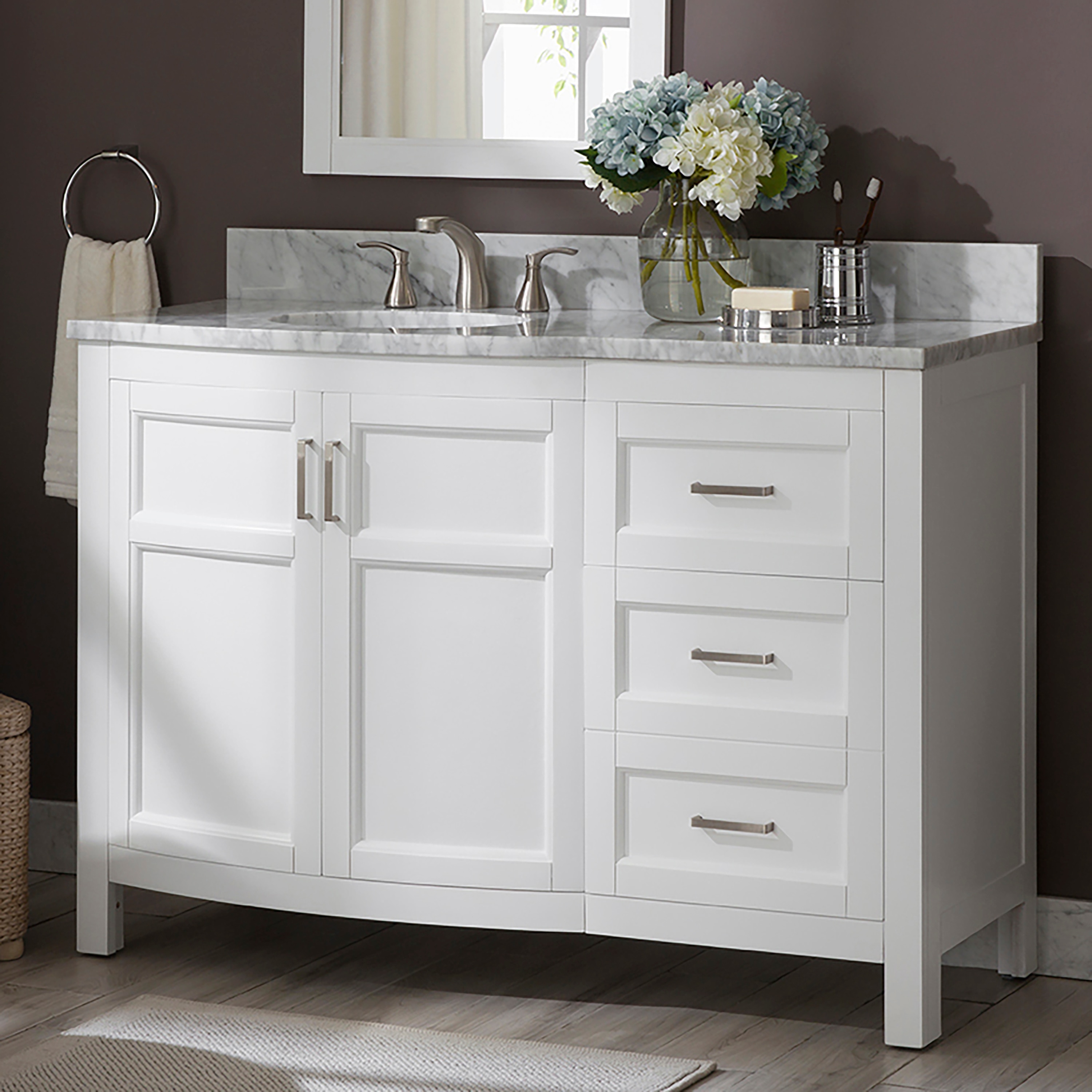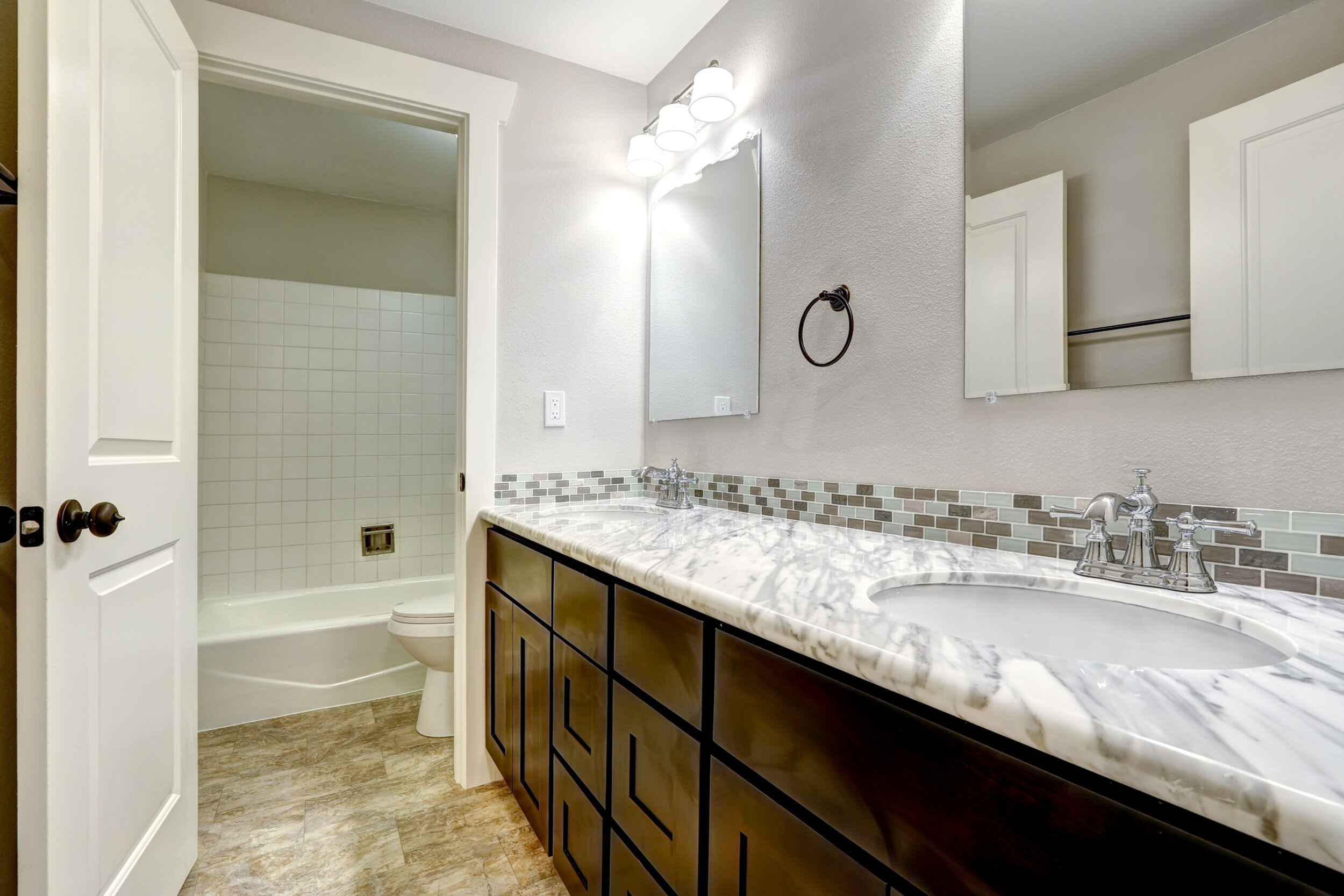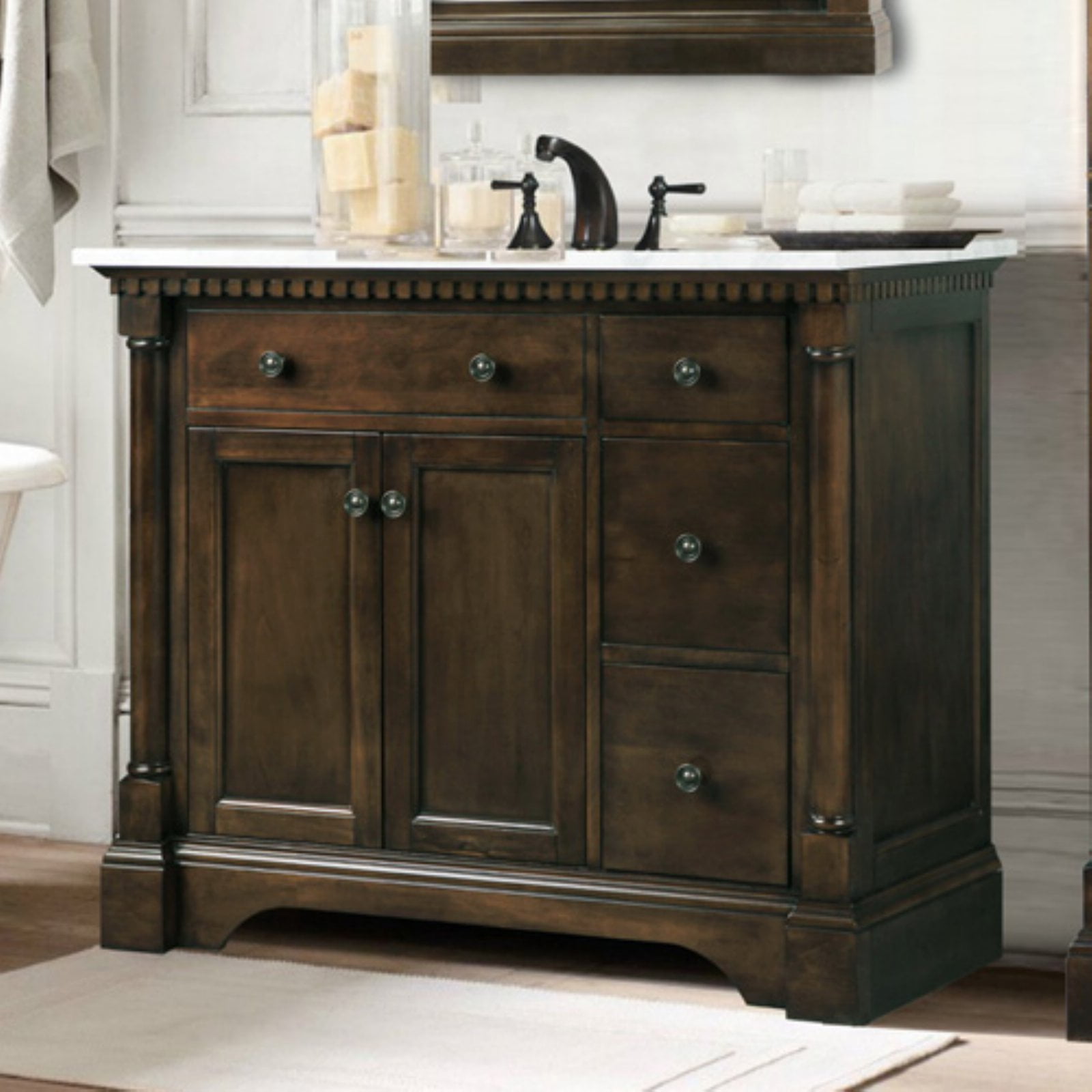Bathroom Vanity Top Materials

Choosing the right material for your bathroom vanity top is an important decision that will impact the look, durability, and maintenance of your bathroom. With a wide range of options available, understanding the pros and cons of each material is crucial to making an informed choice.
Granite
Granite is a natural stone known for its durability, scratch resistance, and heat resistance. It is also a highly porous material, making it susceptible to staining if not properly sealed. However, granite’s natural beauty and wide range of colors and patterns make it a popular choice for bathroom vanity tops.
Pros
- Highly durable and scratch-resistant.
- Heat-resistant.
- Wide range of colors and patterns.
- Can increase the value of your home.
Cons
- Porous, requiring regular sealing to prevent staining.
- Can be expensive.
- Can be heavy, requiring specialized installation.
Examples
A 55×22 inch granite vanity top in a polished black finish with subtle white veining can create a sleek and sophisticated look in a modern bathroom. For a more rustic aesthetic, a 55×22 inch vanity top in a honed brown granite with prominent veining can add warmth and character to a traditional bathroom.
Marble
Marble is another natural stone that is known for its elegance and beauty. It is a softer material than granite, making it more susceptible to scratches and etching. Marble is also porous and requires regular sealing to prevent staining.
Pros
- Elegant and beautiful.
- Available in a wide range of colors and patterns.
- Can add value to your home.
Cons
Examples
A 55×22 inch marble vanity top in a polished white finish with subtle grey veining can create a classic and timeless look in a traditional bathroom. For a more contemporary aesthetic, a 55×22 inch vanity top in a honed black marble with dramatic veining can add a touch of drama and sophistication.
Quartz
Quartz is an engineered stone that is made by combining crushed quartz with resins and pigments. It is a non-porous material that is highly resistant to scratches, stains, and heat. Quartz is also available in a wide range of colors and patterns, making it a versatile option for bathroom vanity tops.
Pros
- Non-porous, making it highly resistant to stains.
- Scratch-resistant and heat-resistant.
- Available in a wide range of colors and patterns.
- Easy to clean and maintain.
Cons
Examples
A 55×22 inch quartz vanity top in a white finish with grey veining can create a clean and modern look in a contemporary bathroom. For a more bold and dramatic look, a 55×22 inch vanity top in a black quartz with gold flecks can add a touch of luxury and sophistication.
Laminate
Laminate is a synthetic material that is made by layering paper or plastic with resin. It is a cost-effective option for bathroom vanity tops, but it is not as durable as natural stone or engineered stone. Laminate is also susceptible to scratches, stains, and heat damage.
Pros
- Cost-effective.
- Available in a wide range of colors and patterns.
- Easy to install.
Cons
Examples
A 55×22 inch laminate vanity top in a white finish with a subtle grey pattern can create a clean and simple look in a small bathroom. For a more modern aesthetic, a 55×22 inch laminate vanity top in a black finish with a metallic pattern can add a touch of sophistication.
Design Considerations for a 55×22 Vanity Top: Bathroom Vanity Tops 55 X 22

A 55×22 inch vanity top offers a balance of functionality and style in a bathroom. This size is suitable for smaller bathrooms while still providing ample space for a sink, storage, and countertop accessories. The design of the vanity top plays a crucial role in its overall aesthetic and usability.
Edge Profiles
The edge profile of a vanity top defines its visual appeal and can influence the overall design style.
- Eased Edge: This profile features a slightly rounded edge, offering a smooth and understated look. It is a popular choice for contemporary and modern bathrooms. An eased edge profile creates a clean, minimalist look, making it a popular choice for modern and contemporary bathroom designs. It can be paired with a variety of sink styles, including undermount sinks, vessel sinks, and drop-in sinks.
- Beveled Edge: A beveled edge features a slanted or angled edge, adding a touch of sophistication to the vanity top. It creates a more traditional or formal aesthetic. A beveled edge profile adds a touch of elegance and sophistication to the vanity top. It is often found in traditional and transitional bathroom designs.
- Ogee Edge: This profile features a curved, S-shaped edge, adding a touch of classic elegance to the vanity top. It is often found in traditional and transitional bathroom designs. An ogee edge profile is a classic choice that adds a touch of elegance to the vanity top. It is often used in traditional and transitional bathroom designs and pairs well with pedestal sinks and undermount sinks.
- Bullnose Edge: This profile features a rounded edge that extends beyond the surface of the vanity top, creating a soft and rounded look. It is a popular choice for traditional and transitional bathrooms. A bullnose edge profile adds a soft and rounded look to the vanity top, making it a popular choice for traditional and transitional bathroom designs. It is often used with drop-in sinks and vessel sinks.
Sink Placement and Bowl Shape
The placement and shape of the sink significantly impact the functionality and aesthetics of the vanity top.
- Undermount Sink: This type of sink is mounted underneath the vanity top, creating a seamless and elegant look. It is a popular choice for modern and contemporary bathrooms. An undermount sink creates a clean and minimalist look, making it a popular choice for modern and contemporary bathroom designs. It is often paired with a countertop made of a non-porous material, such as granite or quartz, as it requires a smooth surface for installation.
- Drop-in Sink: This type of sink sits on top of the vanity top and is typically held in place by a lip or flange. It is a versatile option that can be used with a variety of countertop materials. A drop-in sink is a versatile option that can be used with a variety of countertop materials, including laminate, solid surface, and natural stone. It is often used in traditional and transitional bathroom designs.
- Vessel Sink: This type of sink sits on top of the vanity top and is typically held in place by a pedestal or stand. It is a popular choice for contemporary and modern bathrooms. A vessel sink is a stylish and contemporary option that adds a unique focal point to the bathroom. It is often paired with a vanity top made of a material that complements the sink’s design, such as a natural stone or solid surface.
Bathroom Vanity Top Layout
The layout of the vanity top is essential for maximizing storage space and functionality.
- Storage: Consider the amount of storage space needed for toiletries, towels, and other bathroom essentials. Drawers, cabinets, and shelves can be incorporated into the vanity top to create a functional and organized space. For a 55×22 vanity top, consider incorporating drawers on one or both sides of the sink. This provides ample storage space for toiletries and other bathroom essentials.
- Faucet Placement: The faucet placement should be considered carefully to ensure comfortable use. A standard faucet placement is typically centered over the sink, but it can be adjusted based on the sink style and personal preference. For a 55×22 vanity top, center the faucet over the sink to ensure easy access and optimal water flow.
- Countertop Accessories: Consider the need for countertop accessories such as soap dispensers, toothbrush holders, and trays. Choose accessories that complement the style of the vanity top and provide convenient storage for everyday items. For a 55×22 vanity top, consider adding a soap dispenser and toothbrush holder to the countertop for easy access and organization.
Installation and Maintenance Tips

Installing a bathroom vanity top is a relatively straightforward process, but it requires careful attention to detail and proper tools. Following the steps Artikeld below will help ensure a successful installation and maintain the beauty and functionality of your vanity top for years to come.
Installing a Bathroom Vanity Top, Bathroom vanity tops 55 x 22
Installing a bathroom vanity top involves several steps, ensuring a secure and aesthetically pleasing result.
- Prepare the Vanity Cabinet: Begin by ensuring the vanity cabinet is level and stable. Clean the surface thoroughly to remove any debris or residue.
- Measure and Mark: Measure the vanity cabinet and mark the center point for the vanity top. This will help ensure proper alignment during installation.
- Apply Silicone Sealant: Apply a bead of silicone sealant along the edges of the vanity cabinet where the vanity top will rest. This will create a watertight seal and prevent water damage.
- Position the Vanity Top: Carefully position the vanity top on the cabinet, aligning it with the center point marked earlier. Use shims to level the vanity top if necessary.
- Secure the Vanity Top: Depending on the vanity top material and design, you may need to use screws, clips, or other fasteners to secure the vanity top to the cabinet. Follow the manufacturer’s instructions for specific installation details.
- Clean Up: Once the vanity top is securely installed, clean up any excess sealant or debris. Allow the sealant to cure completely before using the vanity.
Sealing and Maintaining Bathroom Vanity Tops
Proper sealing and maintenance are crucial for extending the lifespan of your bathroom vanity top.
- Sealing Stone and Natural Materials: Natural stone vanity tops, such as granite and marble, require sealing to protect them from stains and water damage. Apply a penetrating sealer to the surface, following the manufacturer’s instructions. Regular resealing, typically every 1-2 years, is recommended.
- Caring for Solid Surface Vanity Tops: Solid surface vanity tops, like Corian or quartz, are generally non-porous and require less maintenance than natural stone. However, regular cleaning with a mild cleaner and a soft cloth is recommended. Avoid abrasive cleaners that can scratch the surface.
- Maintaining Laminate Vanity Tops: Laminate vanity tops are durable and easy to clean. Use a mild cleaner and a soft cloth to wipe down the surface. Avoid using abrasive cleaners or harsh chemicals that can damage the laminate.
Addressing Common Issues with Bathroom Vanity Tops
While bathroom vanity tops are designed to withstand moisture and daily use, certain issues may arise over time.
- Cracks or Chips: If your vanity top develops cracks or chips, it’s essential to address them promptly to prevent further damage. For minor chips, you can use a specialized epoxy filler to repair the area. For larger cracks, you may need to contact a professional for repairs or replacement.
- Staining: Staining can occur on porous materials like natural stone. Promptly clean up spills and avoid using harsh chemicals that can etch the surface. Regularly sealing the surface can help prevent staining.
- Water Damage: Water damage can occur if the sealant around the vanity top fails. Regularly inspect the sealant and reapply it as needed to prevent water from seeping underneath the vanity top.
